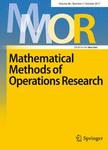版权所有:内蒙古大学图书馆 技术提供:维普资讯• 智图
内蒙古自治区呼和浩特市赛罕区大学西街235号 邮编: 010021

作者机构:Hebei Univ Technol Inst Math Xiping Rd 5340 Tianjin 300401 Peoples R China Chinese Acad Sci Acad Math & Syst Sci ICMSEC LSEC Zhongguancun East Rd 55 Beijing 100190 Peoples R China
出 版 物:《MATHEMATICAL METHODS OF OPERATIONS RESEARCH》 (运筹学研究中的数学方法)
年 卷 期:2022年第96卷第3期
页 面:351-382页
核心收录:
学科分类:12[管理学] 1201[管理学-管理科学与工程(可授管理学、工学学位)] 07[理学] 070105[理学-运筹学与控制论] 0701[理学-数学]
基 金:NSFC [12071108, 11671116, 12021001, 11991021, 11991020, 11971372, 11701137] National Key R&D Program of China [2021YFA1000300, 2021YFA1000301] Strategic Priority Research Program of Chinese Academy of Sciences [XDA27000000] Natural Science Foundation of Hebei Province [A2021202010]
主 题:Nonlinear programming Interior-point relaxation method Smoothing method Logarithmic-barrier problem Mini-max problem Global and local convergence
摘 要:Based on solving an equivalent parametric equality constrained mini-max problem of the classic logarithmic-barrier subproblem, we present a novel primal-dual interior-point relaxation method for nonlinear programs with general equality and nonnegative constraints. In each iteration, our method approximately solves the KKT system of a parametric equality constrained mini-max subproblem, which avoids the requirement that any primal or dual iterate is an interior-point. The method has some similarities to the warmstarting interior-point methods in relaxing the interior-point requirement and is easily extended for solving problems with general inequality constraints. In particular, it has the potential to circumvent the jamming difficulty that appears with many interior-point methods for nonlinear programs and improve the ill conditioning of existing primal-dual interior-point methods as the barrier parameter is small. A new smoothing approach is introduced to develop our relaxation method and promote convergence of the method. Under suitable conditions, it is proved that our method can be globally convergent and locally quadratically convergent to the KKT point of the original problem. The preliminary numerical results on a well-posed problem for which many interior-point methods fail to find the minimizer and a set of test problems from the CUTEr collection show that our method is efficient.